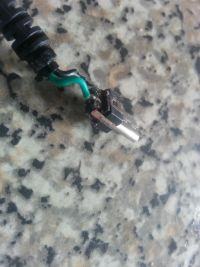Hello
I will add that I have not soldered much in my life, but I have recently encountered a problem.
I wanted to repair a broken phone charger, to do this I had to solder one cable to the microUSB plug. I was terribly surprised because I could not solder it, tin stuck to the wire as much as possible, but nothing and nothing wanted to stick to the plug. In the red circle in the picture I marked an area where I can't solder anything (anticipating the question, I didn't want to solder the wire there).

Finally, I decided that I would do like my colleague some time ago and just use the Droplet. It was more of an experiment, but a colleague claimed that the droplet of current does not conduct and that it can be safely glued on 5V. This way I was surprised again because the droplet did not hold anything and after the place marked in red it just flowed down and in this way I sealed it so that it could not even be inserted into the phone, it can be thrown away.
My question is: why couldn't I solder in this place ?? I need some special tin or something ??
The soldering iron and tin that I use are:
https://sklep.avt.pl/pistoletowa-lutownica-elektryczna-vtsg130n.html
https://sklep.avt.pl/cyna-f-1-00-lc60-fiolka.html
I will add that I have not soldered much in my life, but I have recently encountered a problem.
I wanted to repair a broken phone charger, to do this I had to solder one cable to the microUSB plug. I was terribly surprised because I could not solder it, tin stuck to the wire as much as possible, but nothing and nothing wanted to stick to the plug. In the red circle in the picture I marked an area where I can't solder anything (anticipating the question, I didn't want to solder the wire there).

Finally, I decided that I would do like my colleague some time ago and just use the Droplet. It was more of an experiment, but a colleague claimed that the droplet of current does not conduct and that it can be safely glued on 5V. This way I was surprised again because the droplet did not hold anything and after the place marked in red it just flowed down and in this way I sealed it so that it could not even be inserted into the phone, it can be thrown away.
My question is: why couldn't I solder in this place ?? I need some special tin or something ??
The soldering iron and tin that I use are:
https://sklep.avt.pl/pistoletowa-lutownica-elektryczna-vtsg130n.html
https://sklep.avt.pl/cyna-f-1-00-lc60-fiolka.html


